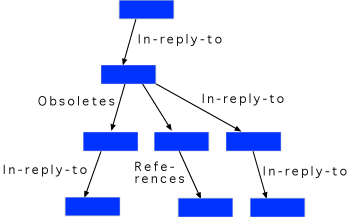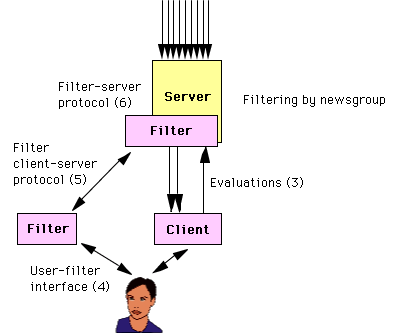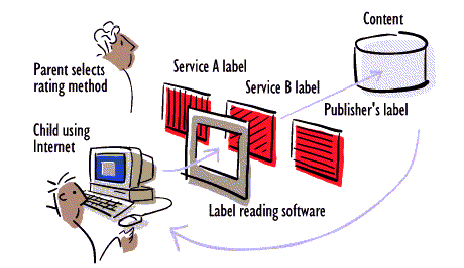INTRODUCTION
Information Overload, Quality Enhancement
|
|
Much of the information on the Internet today consists of documents made available
to many recipients through mailing lists, distribution lists, bulletin boards, asynchronous
computer conferences, newsgroups, and the World Wide Web.
Common to mailing lists and forums is that the originator
of a message need only give the name of one recipient, the name of the group (mailing
list, bulletin board, computer conference, forum, closed group, etc.) The messaging
network will then distribute the message to each of the members of the group, with
no extra effort for the originator. The average effort of writing a simple message
is about four minutes, and the average effort of reading a message is about half
a minute [Palme 1981], so if there are more than about eight recipients to a message,
the total reading time is larger than the total writing time, and if there are hundreds
or thousands of recipients, the total reading time caused by the originator is many
times larger than his effort in writing the message.
Because of this, Internet users will easily become
overloaded with messages [Denning 1982, Palme 1984, Hiltz and Turoff 1985, Malone
1987]. This issue can also be seen as a quality problem: people want to read the
most interesting messages, and want to avoid having to read low-quality or uninteresting
messages.
Filtering is tools to help people find the most valuable
information, so that the limited time spent on reading/listening/viewing can be spent
on the most interesting and valuable documents. Filters are also used to organize
and structure information. Filters are, for most users, more important for group
messages (messages sent to mailing lists and forums) than for individually addressed
mail. Filtering is also needed on the search results from Internet search engines.
Future software for the Internet can be expected to employ more advanced and user-friendly
filtering functions than today, in order to support less computer-specialist users.
Since people download millions of messages and web documents every day, and very
often do not immediately get what they would mostly like to get, the gains through
better filtering are enormous. Even a filter with a 10 % efficiency gain, the gain
would be worth billions of dollar a year. |
Before the Internet
|
 |
Human society has always employed methods to control and restrict the flow of information.
When this is done to satisfy the needs of the government, it is named censorship.
But most of this control in democratic countries is done to satisfy the needs of
the recipients. |
 |
Publishers, journalists, editors provide an accepted service of selecting the most
valuable information to their customers, the readers of books, journals, newspapers,
the radio listeners and the television viewers. |
| |

Schools and universities select which information to teach the students based on
scholarly criteria. The intention is again to help the customers, the students, to
get the most out of a course.

Political organizations select what information is discussed in their organizations
and distributed to their members. |
 |
Governments control information through laws and the legal system.
This control of the information flow is done in the
interest of many groups. Politicians want to control what information is given about
their activities. The establishment wants to control information flow to protect
itself and to control society. The scientific community wants to control information
to uphold scientific quality, but has also many times tried to restrict novel research
outside of the established paradigms. So control if information flow is not only
done to help recipients of information. |
What is different with the Internet?
|
|
On the Internet, almost anyone can easily and at low cost publish anything they want.
This means that a vast amount of information of varying quality is disseminated.
There are lots of interesting things, but also lots of trash. (Not that everyone
agrees on what is interesting and what is trash, of course.) Can the Internet develop
tools to help its users find the most valuable and interesting information? Should
this be done, on the Internet, using the same methods as in the pre-internet society,
or can novel methods be developed? |
Major filtering methods
|
 |
- Automatic filtering is where the computer evaluates what is of value for
you.
|
 |
- Social filtering (also known as collaborative filtering) is tools
where other people help you evaluate what is of most value to read. Just like the
publishers and organizations did in society before the Internet.
The most successful social filtering system is Yahoo. Yahoo employs humans to
evaluate documents, and puts documents, which are interesting into its structured
information database. This is very similar to what the publishers, editors, journalists
and organizations did in the world before the Internet.
The simplest and most common filtering is by organizing
discussions into groups (newsgroups, mailing lists, forums, etc.) Each group has
a topic, and wants only contributions within that topic. Sometimes the right to submit
contributions is restricted. A common variant is that only members can submit, and
sometimes competence control is done before accepting a new member. Another variant
is that special moderators must approve contributions before distribution. The act
when a recipient selects which groups to subscribe to, can thus be seen as an act
of setting a personal filter.
|
|

|
| |
Another simple and common filtering method is to filter by thread. A thread is a
set of messages, which directly or indirectly refer to each other. People can use
threads for filtering by specifying that they want to skip reading of existing and
future contributions in certain threads. In Usenet News, this functionality is known
under the term "kill buffer".
Automatic filtering has been successful only with very simple filters. Advanced
methods for "intelligent" filtering have in general not been very
successful. Intelligent filtering is a complex task requiring intelligence which
computers are maybe not yet capable of? |
FILTERING ISSUES
Filtering rules and attributes
|
|
Filtering is done by applying filtering rules to attributes of the documents to be
filtered. Filtering rules are usually Boolean conditions. They are often put in an
ordered list, which is scanned for each item to be filtered. The order of the items
in the list can sometimes influence the outcome of the filtering, in ways, which
the user does not understand well.
The attributes of documents, to be used in filtering,
are words in the titles, abstracts or the whole document, automatic measurements
of stylistic and language quality [Karlgren 1994, Tzolas 1994], name of author, and
ratings on the documents supplied by its author or by other people. |
Filtering of threads
|
|
In discussion groups, messages often belong to threads (see above). It may then not
be possible to understand a single message without seeing other messages in the same
thread. A filter or search facility which only selects certain individual messages,
out of threads, might then not satisfy their users. The filter must either select
several items in the thread, or at least make it very easy for users, when reading
one selected message, to traverse the tree up and down from this message. |
Filtering in client or server
|
| |
Filtering can be done in servers or in clients. |
|

|
| |
The figure above shows how a server can filter messages before downloading them to
the client. The advantage with this is that filtering can be done in the background,
and that messages filtered away need never be downloaded to the client. The disadvantage
is that communication between user and filtering system becomes more complex. IETF
is currently working on the development of a standard for the user control of server
based filtering in a working group on MTA filtering [see IMC 1997].
Alternatively, filters may be part of the client, and
apply to sets of documents after they have been downloaded to the client, as shown
by the figure below: |
Delivery of filtering results
|
|
The most common way of delivery of filtering results is that documents are filtered
into different folders. Users choose to read new items one folder at a time. Thus,
the filter helps users read messages on the same topic at the same time. The user
can also have a personal priority on the order of reading news in different folders.
Unwanted messages can be filtered to special "trashcan"
folders. User may choose not to read them at all, or to read such folders only very
cursorily.
Filtering can also be used to mark messages within
a folder. Different colors or priority indications can be put on the messages, or
the messages may be sorted, with the most interesting first in the list.
Most services deliver new documents with a list, from
which the user can select which items to read or not to read. The user act of selecting
what to read from such a list can also be seen as a kind of filtering. The figure
below shows an example of such a list, taken from the Web4Groups system [Palme 1997]: |

  time, time, time , by Andras Micsik <micsik@sztaki.hu> 16/09/97
09:36 (2) time, time, time , by Andras Micsik <micsik@sztaki.hu> 16/09/97
09:36 (2)
   Re: Advanced Functionalities , by Alain Karsenty <karsenty@eurecom.fr> 16/09/97
10:28 (1) Re: Advanced Functionalities , by Alain Karsenty <karsenty@eurecom.fr> 16/09/97
10:28 (1)
  Re: Web4Groups Technical
Forum , by Torgny Tholerus 16/09/97 10:41 (1) Re: Web4Groups Technical
Forum , by Torgny Tholerus 16/09/97 10:41 (1)
   Re: Web4Groups Technical Forum , by Torgny
Tholerus 16/09/97 10:42 Re: Web4Groups Technical Forum , by Torgny
Tholerus 16/09/97 10:42
   Re: Web4Groups Technical Forum , by Torgny
Tholerus 16/09/97 10:42
(1) Re: Web4Groups Technical Forum , by Torgny
Tholerus 16/09/97 10:42
(1)
   Re: Re: Web4Groups Technical Forum , by <MAILER-DAEMON@dsv.su.se> 16/09/97 11:38 Re: Re: Web4Groups Technical Forum , by <MAILER-DAEMON@dsv.su.se> 16/09/97 11:38
   Re: Draft agenda for Sophia-Antipolis , by Jacob Palme <jpalme@dsv.su.se> 20/09/97
04:35 Re: Draft agenda for Sophia-Antipolis , by Jacob Palme <jpalme@dsv.su.se> 20/09/97
04:35
   Re: Web4Groups test report, by Jacob Palme <jpalme@dsv.su.se> 24/09/97
13:36 Re: Web4Groups test report, by Jacob Palme <jpalme@dsv.su.se> 24/09/97
13:36
   Re: Web4Groups test report, by Jacob Palme <jpalme@dsv.su.se> 24/09/97
13:36 Re: Web4Groups test report, by Jacob Palme <jpalme@dsv.su.se> 24/09/97
13:36 |
Intelligent filtering
|
|
By intelligent filtering is meant use of artificial intelligence (AI) methods to
enhance filtering. This can be done in different ways: AI software can be used to
derive attributes for documents, which are then used for filtering, it can be used
to derive filtering rules, or it can be used for the filtering process itself. With
the machine learning approach, the filter will take as input information from the
user about which documents the user likes, and will then look at these messages and
try to derive common characteristics of them to be used in future filtering.
Such filtering can be done in the background, behind
the scenes, with little or no interaction with the user, or it can be done in a way
where a user can interact with the filter and help the filter understand why the
user likes certain messages. A disadvantage with much user interaction is that it
takes user time, and the whole idea of filtering is to save user time. A disadvantage
with very automatic filtering is that the user may not trust a filter if the user
does not understand how it works.
If an AI method is used to derive filtering rules, it might be valuable if these
rules are specified in a way which a human can understand and trust. Certain AI methods,
the so-called genetic algorithms, are known to produce very unintelligible rules
and this may be a reason against using them for information filtering. |
Filtering against spamming
|
|
Many people want filters which will remove unsolicited direct marketing e-mail
messages, so-called spamming. To do this, the filter has to recognize special properties
of spam messages, which distinguish them from other messages. Examples of such properties
are:
- A message does not have your name or e-mail address in the message heading, but
it does not come from any mailing list, which you subscribe to. Many, but not all,
such messages are spams. I personally let my filter mark all such messages with a
blue color, so that I can easily check whether to read them or not.
- The author or sender of a message has an illegal e-mail address. Many MTAs (mail
servers) now stop such messages, and because of this, the spammers have started to
use legal e-mail addresses as senders. This is a general problem: If a particular
filtering method gets very much used, spammers will change their messages to avoid
being filtered.
- Certain words, such as "money" or "$$$" in the subject. This
is not very dependable. It has the same problem as all intelligent filtering, see
above.
- If you often get similar spams, you might be able to recognize special properties
of them to use to stop further similar spams.
- The same message, with identical content, was sent to very many users, or to
several newsgroups or mailing lists, at the same time. This method is commonly used
for stopping spams in mailing lists and in Usenet News, and it seems to work, but
spammers are beginning to learn to circumvent this, too.
None of these methods are very efficient. A social filtering system might be more
efficient, see the next chapter.
|
SOCIAL FILTERING
What is social filtering
|
|
By social filtering is meant that some kind of ratings are assigned to documents.
The ratings can be compared to the stars  which newspapers often assign to films, books
and other consumer products. But the ratings can also include categorization into
subject areas or according to particular scales. Social filtering has some similarities
to the filtering done by editors, journalists and publishers, since in both cases
humans select the filtering attributes. which newspapers often assign to films, books
and other consumer products. But the ratings can also include categorization into
subject areas or according to particular scales. Social filtering has some similarities
to the filtering done by editors, journalists and publishers, since in both cases
humans select the filtering attributes. |
Why use social filtering
|
|
It is difficult to design automatic or intelligent filtering algorithms which really
can evaluate the content of a document and evaluate its value. Humans are more capable
of really deciding the value of a document. |
Who make the ratings?
|
|
Ratings for use in social filtering can be provided by:
- Editors, special people with the task of doing such rating. An example
is the people selecting which messages to put into services like Yahoo [Yahoo 1998].
- Readers, ordinary readers might input ratings on what they read, and these
ratings might be collected and put into databases to help other people. Firefly [Firely
1996] and Grouplens [Resnick et al 1994A, 1994B] are systems based on this method.
- Authors can provide certain kinds of ratings themselves. The advantage
is that authors may be more willing to produce ratings, a disadvantage may be that
an author might give too high ratings to his/her own documents. Because of this,
author ratings are mostly useful if objective scales are used.
A filter may use an average or median of the ratings put by all who have rated
a document. It might be better to use something like the upper quartile, since documents
liked very much by a few people may be of particular interest, because they provide
new thoughts and ideas. A filter might also base its filtering on the ratings done
by other people with similar values, views and knowledge as the filter user. The
filtering system might automatically find such people with similar views to the filter
user.
|
Rating collection
|
|
A rating system must collect ratings from the people who do the rating. This can
be done explicitly, where the user gives a rating command after reading a message.
It can also be done implicitly, by studying variables like the time a user has spent
on a message, whether the user has written a reply to it, printed it on paper, etc.
Some studies Indicate that such implicit rating can give as good values as explicit
ratings. The advantage, of course, is that people may forgot to provide explicit
ratings.
Ratings collected in this way can be used for social
filtering. But they can also be used as input to intelligent filtering algorithms
(see above). And this might be a way of getting people to provide ratings, since
people will have a personal gain by providing ratings: This will make the intelligent
filtering for themselves work better. |
Spamming of social filtering systems
|
|
By spamming is meant ways in which people can cheat the system to force messages
on you which you do not want. Most people think of spamming as it is done in e-mail
or in Usenet News. But another variant of spamming is performed against Internet
search engines. Authors of web documents give faulty keywords to their documents,
to cheat the search engine into selecting the document by inserting the most popular
search terms, which are known to be words like "sex", "naked",
"girl", etc., even if these words are not related to the actual content
of the document. Some search engines will first show you documents which contain
the search word many times, so spammers may repeat the same word many times in the
keyword set. (Keywords are placed in the meta fields of a HTML documents, which is
not shown when you read the document with a web browser.)
Search engine providers have developed methods to recognize
and dismiss messages with such false keywords. If social filtering systems are used
in the future, there is an obvious risk that spammers will try to cheat the system,
by entering lots of false positive ratings of their web pages. To stop this, some
kind of authentication of raters may be needed. |
Privacy issues
|
|
If a social filtering data base stores information, for individual raters, of which
documents they like and dislike, such storage may be used for infringement of privacy.
Possibly, some encryption method might be used to make such invasion impossible or
difficult. This will of course depend on trust between user and filtering service.
Web search engines today have similar privacy issues: They can store information
about what you search for on the web. They already use this information to target
selection of banner advertisements - other uses, which you might not like, may also
occur. |
RESEARCH ON FILTERING
How research on filtering is usually done
|
|
There are many research projects on information filtering. Such a project is usually
started by some clever computer scientist, who has some novel idea of how to do filtering.
He or she often finds that the task of developing a complete filtering system is
larger than expected. If there was a standardized architecture for filtering systems,
with standardized interface between modules, a researcher might easier be able to
reuse existing modules, so that not a whole new filtering system has to be developed,
when the researcher only wants to try out some new idea for one particular module. |
Evaluation of filtering results
|
|
To evaluate a new filtering method, or to compare different filtering methods, one
might compare the filtering with manual ratings of documents done by users. A filter
which will be good at predicting the ratings done by a user would then be regarded
as a good filter. Of course, an intelligent filter should not derive its filtering
rules from one set of messages, and then test the filter on the same set. In the
most extreme case, if a user found message 1, 3, 17, 32, 36, 53, 55, 58, 72, 76 and
84 best, a genetic algorithm might derive the rule: Select all messages with number
1, 3, 17, 32, 36, 53, 55, 58, 72, 76 or 84. Such a filtering rule would of course
be totally valueless. Even if filtering is developed and tested on different sets
of messages, there is still a risk that a filtering method is developed which only
suits the test subjects. To avoid this, a large and varied set of test subjects should
be used. |
ARCHITECTURE AND STANDARDS
Architectural issues
|
|
To reduce the burden of developing and testing different filtering rules, it would
be very valuable to develop a standardized architecture and standardized interfaces
between the modules. The SELECT
EU project [Palme 1998], which will start in the autumn of 1998, will work on
this. Some modules which this project will specify are:
- Storage of author ratings
- Storage of personal and social filtering ratings
- User control of filtering rules
- Format and storage of filtering rules
- Filtering agent
- Attribute creators
|
The PICS standard
|
|

|
|
(Picture from Resnick 1996A)
The PICS standard was mainly developed as a tool for teachers and parents to censor
the information which children can download from the Internet. But PICS can be useful
in other ways. It provided a general-purpose, standardized way of storing and distributing
ratings. Users or groups of users of PICS can, within the PICS standard, specify
their own rating scales. PICS might thus be useful as a basis for some of the interfaces
between the different modules of the filtering infrastructure.
|
The MTA filtering proposals
|
|
Another on-going standards work in the filtering area is the IETF work on MTA filtering
[IMC 1997]. IETF is developing a basic standard for controlling server-based filters. |
MORE INFORMATION
Overview of research and services
Different approaches
|
|
The issue of finding better-quality information on the Internet (in web documents,
newsgroup postings, mailing list contributions, etc. below the word "document"
is used) has been discussed and tackled in many different ways. A good collection
of links to these issues can be found in [Ciolek 1994-1997]. Approaches taken have
been:
- Automatic tools for finding and correcting technical faults in documents,
such as non-working links in WWW pages, were proposed in IETF work in 1994 and our
now a part of many web server maintenance tools. Their usage is sporadic and can
therefore not assure a general improvement of quality.
- Making newsgroups and mailing lists pre-moderated, with a moderator who must
accept all contributions before they are sent out, can be an efficient tool in increasing
quality. This method has however the disadvantage that interaction is delayed, and
that the group depends on the moderator. In practice, it has been found that to ensure
continuous flow, there has to be a group of several moderators so that one can replace
another who is on travel or ill.
- Another similar method is possible for mailing lists and in most computer conferencing
systems but not in Usenet News: Closed groups where only selected people are
allowed to participate. This requires someone to wet applications for membership
and in general closed groups often die out because of too few members and lack of
activity.
- Education of document authors and maintainers on quality issues is a never-ending
work which will surely improve the quality at some places. A related method is to
establish rules, procedures or ethical guidelines for documents and try to get them
generally accepted. Such work is surely valuable, but if Internet is to stay a medium
where anyone can put up anything they want, no full solution to the quality problem.
- There is a large and rapidly increasing set of journals on the Internet, where
contributions are selected in similar ways as in ordinary journals, for example scientific
journals with peer review processes.
- Much work in different places has been spent on developing so-called subject
trees or subject structures, i.e. maintained and well-organized databases
of links to high-quality documents. Most well known is the Yahoo service [Yahoo 1998].
Some Internet search services have started to provide quality evaluations or reviews
(Magellan from McKinley [Magellan 1997], Excite, OCLC's NetFirst, SBIG's [see Koch
1996A]), and the DESIRE telematics project [Koch 1996B] has as one of its major goals
to develop quality assured collections for different subject areas. Another example
is The Argus Clearinghouse (which started at the University of Michigan but is now
a commercial company) which provides labels on Internet subject structures with descriptions
and manually set quality ratings, in many ways similar to the quality labels specified
the Centre for Information Quality Management. Such databases are developed and maintained
by time-consuming human work, which limits their size and scope. The largest, Yahoo
has for example less than a hundred thousand documents compared to tens of millions
of documents in the largest Internet search servers. They are also not suitable for
transient information, such as mailing list, computer conferencing and netnews contributions.
- One problem with the Internet is that documents come and go, and even valuable
documents disappear. To solve this, some libraries have started scanning the net
and archiving copies of documents available on the Internet for future retrieval.
Another method is the work in IETF of developing URIs (Uniform Resource Identifiers),
which are meant to be document references which do not have to change as rapidly
as the currently used URLs (Uniform Resource Locators). Special URI servers are meant
to translate a URI to a URL when a document is to be retrieved.
- The PICS (Platform for Internet Content Selection) [Resnick 1996A, Resnick
1996B, Krauskopf 1996] of the World Wide Web Consortium has developed a standard
protocol for content labels (labels with information about the quality of information
resources), how to embed them in other Internet protocols and how to run label bureaus
(service organizations providing labels). The primary incentive for PICS was the
protection of children from unsuitable information, but the PICS protocols can be
used to convey many kinds of quality labels, and SELECT may decide to use the PICS
protocol for some of its modules.
- The Centre for Information Quality Management set up by the UK Online User Group
of the Library Association has worked on specifying a format for quality labeling
of databases. Quality labeling is a format for a producer of a database to specify
the characteristics of his database in unbiased ways, similar to consumer product
standards for consumer information labels.
|
Existing rating and filtering services and research projects
|
|
Many research projects are going on or finished in the area of information filtering.
- Patrick van Bommel at the University of Nijmegen maintains good overview pages
of ongoing research at [Bommel 1997].
- Sepia Technologies, Inc in Quebec, Canada, has developed a collaborative filtering
system for movies, music and books, see [Sepia 1995].
- Surflogic LLC in San Francisco has developed Surfbot, a web browser plug in which
will search for and filter information on the net according to a users needs.
- The Department of Computer and Systems Sciences at KTH and SU has just finished
a research project INTFILTER on intelligent filters. The result of this project can
be found in [Kilander 1997]. A new EU project SELECT will start in the autumn of
1998 [Palme 1998].
- The most well known application of social filtering, Firefly [Firefly 1997],
a commercial company which keeps a database of ratings of movies, music and other
information. A user can connect, input his favorite movie or music, and be told which
other movies and music where rated highly by people with similar tastes as the user.
- The MIT Media Laboratory has a project on filtering agents led by professor Pattie
Maes. They are also studying social filtering.
- The MIT Center for Coordination Science has developed GroupLens, a social filtering
system for Usenet News [Resnick et al 1994A, 1994B].
|










